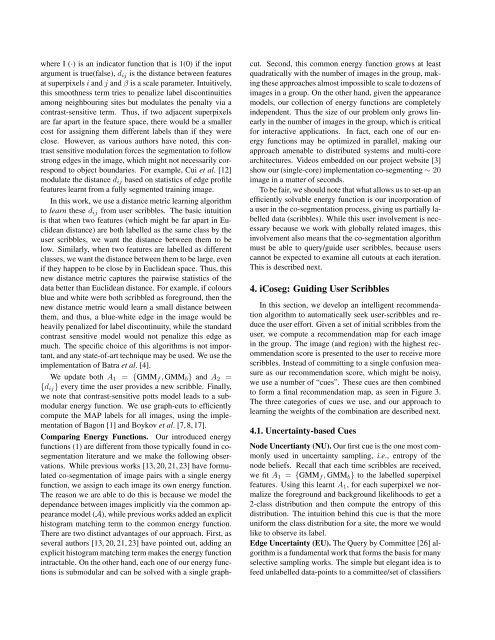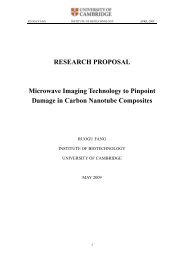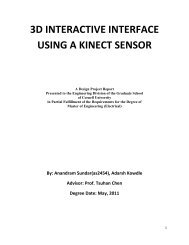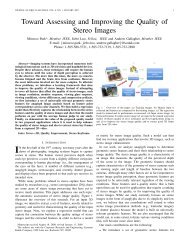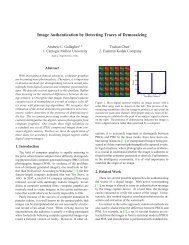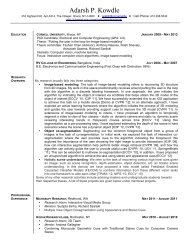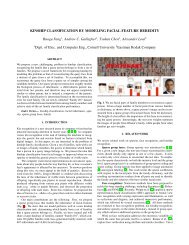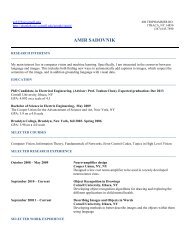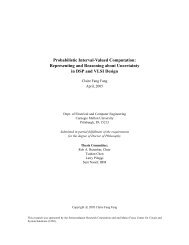iCoseg: Interactive Co-segmentation with Intelligent Scribble Guidance
iCoseg: Interactive Co-segmentation with Intelligent Scribble Guidance
iCoseg: Interactive Co-segmentation with Intelligent Scribble Guidance
You also want an ePaper? Increase the reach of your titles
YUMPU automatically turns print PDFs into web optimized ePapers that Google loves.
where I (·) is an indicator function that is 1(0) if the input<br />
argument is true(false), dij is the distance between features<br />
at superpixels i and j and β is a scale parameter. Intuitively,<br />
this smoothness term tries to penalize label discontinuities<br />
among neighbouring sites but modulates the penalty via a<br />
contrast-sensitive term. Thus, if two adjacent superpixels<br />
are far apart in the feature space, there would be a smaller<br />
cost for assigning them different labels than if they were<br />
close. However, as various authors have noted, this contrast<br />
sensitive modulation forces the <strong>segmentation</strong> to follow<br />
strong edges in the image, which might not necessarily correspond<br />
to object boundaries. For example, Cui et al. [12]<br />
modulate the distance dij based on statistics of edge profile<br />
features learnt from a fully segmented training image.<br />
In this work, we use a distance metric learning algorithm<br />
to learn these dij from user scribbles. The basic intuition<br />
is that when two features (which might be far apart in Euclidean<br />
distance) are both labelled as the same class by the<br />
user scribbles, we want the distance between them to be<br />
low. Similarly, when two features are labelled as different<br />
classes, we want the distance between them to be large, even<br />
if they happen to be close by in Euclidean space. Thus, this<br />
new distance metric captures the pairwise statistics of the<br />
data better than Euclidean distance. For example, if colours<br />
blue and white were both scribbled as foreground, then the<br />
new distance metric would learn a small distance between<br />
them, and thus, a blue-white edge in the image would be<br />
heavily penalized for label discontinuity, while the standard<br />
contrast sensitive model would not penalize this edge as<br />
much. The specific choice of this algorithms is not important,<br />
and any state-of-art technique may be used. We use the<br />
implementation of Batra et al. [4].<br />
We update both A1 = {GMMf , GMMb} and A2 =<br />
{dij} every time the user provides a new scribble. Finally,<br />
we note that contrast-sensitive potts model leads to a submodular<br />
energy function. We use graph-cuts to efficiently<br />
compute the MAP labels for all images, using the implementation<br />
of Bagon [1] and Boykov et al. [7, 8, 17].<br />
<strong>Co</strong>mparing Energy Functions. Our introduced energy<br />
functions (1) are different from those typically found in co<strong>segmentation</strong><br />
literature and we make the following observations.<br />
While previous works [13, 20, 21, 23] have formulated<br />
co-<strong>segmentation</strong> of image pairs <strong>with</strong> a single energy<br />
function, we assign to each image its own energy function.<br />
The reason we are able to do this is because we model the<br />
dependance between images implicitly via the common appearance<br />
model (A), while previous works added an explicit<br />
histogram matching term to the common energy function.<br />
There are two distinct advantages of our approach. First, as<br />
several authors [13, 20, 21, 23] have pointed out, adding an<br />
explicit histogram matching term makes the energy function<br />
intractable. On the other hand, each one of our energy functions<br />
is submodular and can be solved <strong>with</strong> a single graph-<br />
cut. Second, this common energy function grows at least<br />
quadratically <strong>with</strong> the number of images in the group, making<br />
these approaches almost impossible to scale to dozens of<br />
images in a group. On the other hand, given the appearance<br />
models, our collection of energy functions are completely<br />
independent. Thus the size of our problem only grows linearly<br />
in the number of images in the group, which is critical<br />
for interactive applications. In fact, each one of our energy<br />
functions may be optimized in parallel, making our<br />
approach amenable to distributed systems and multi-core<br />
architectures. Videos embedded on our project website [3]<br />
show our (single-core) implementation co-segmenting ∼ 20<br />
image in a matter of seconds.<br />
To be fair, we should note that what allows us to set-up an<br />
efficiently solvable energy function is our incorporation of<br />
a user in the co-<strong>segmentation</strong> process, giving us partially labelled<br />
data (scribbles). While this user involvement is necessary<br />
because we work <strong>with</strong> globally related images, this<br />
involvement also means that the co-<strong>segmentation</strong> algorithm<br />
must be able to query/guide user scribbles, because users<br />
cannot be expected to examine all cutouts at each iteration.<br />
This is described next.<br />
4. <strong>i<strong>Co</strong>seg</strong>: Guiding User <strong>Scribble</strong>s<br />
In this section, we develop an intelligent recommendation<br />
algorithm to automatically seek user-scribbles and reduce<br />
the user effort. Given a set of initial scribbles from the<br />
user, we compute a recommendation map for each image<br />
in the group. The image (and region) <strong>with</strong> the highest recommendation<br />
score is presented to the user to receive more<br />
scribbles. Instead of committing to a single confusion measure<br />
as our recommendation score, which might be noisy,<br />
we use a number of “cues”. These cues are then combined<br />
to form a final recommendation map, as seen in Figure 3.<br />
The three categories of cues we use, and our approach to<br />
learning the weights of the combination are described next.<br />
4.1. Uncertainty-based Cues<br />
Node Uncertianty (NU). Our first cue is the one most commonly<br />
used in uncertainty sampling, i.e., entropy of the<br />
node beliefs. Recall that each time scribbles are received,<br />
we fit A1 = {GMMf , GMMb} to the labelled superpixel<br />
features. Using this learnt A1, for each superpixel we normalize<br />
the foreground and background likelihoods to get a<br />
2-class distribution and then compute the entropy of this<br />
distribution. The intuition behind this cue is that the more<br />
uniform the class distribution for a site, the more we would<br />
like to observe its label.<br />
Edge Uncertainty (EU). The Query by <strong>Co</strong>mmittee [26] algorithm<br />
is a fundamental work that forms the basis for many<br />
selective sampling works. The simple but elegant idea is to<br />
feed unlabelled data-points to a committee/set of classifiers


